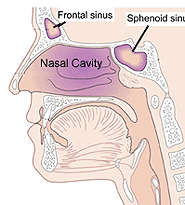Human Structure Virtual Histology
|
Respiratory System, The Nasal Cavity |
|
|
 The
nasal cavities are paired chambers that function to filter,
warm, and humidify inspired air. Vibrissae (short, stiff hairs) and
mucous secretions trap inhaled particulate matter that is then swept
by the action of the ciliated respiratory epithelium away from the
respiratory passages. Blood-filled venules in the respiratory mucosa
help warm the inspired air, and glandular secretions help moisten
it. The
nasal cavities are paired chambers that function to filter,
warm, and humidify inspired air. Vibrissae (short, stiff hairs) and
mucous secretions trap inhaled particulate matter that is then swept
by the action of the ciliated respiratory epithelium away from the
respiratory passages. Blood-filled venules in the respiratory mucosa
help warm the inspired air, and glandular secretions help moisten
it.
- Examine the nasal cavities in
this slide of fetal
mouse head. Note their division by the nasal septum and the
projecting turbinates (conchae), which protrude into the
cavities and serve to increase surface area and air turbulence.
- In the nasal mucosa covering the
cartilage, identify the following features: pseudostratified
columnar, ciliated epithelium and venules and serous-mucous
glands in the underlying CT. At the dorsal surface of the nasal
cavities, the lining epithelium is modified as olfactory
epithelium. However, it does not yet appear to be fully
differentiated in this fetal tissue.
- Next, examine this sample of
olfactory
epithelium. Note the thick pseudostratified columnar,
ciliated olfactory epithelium. This epithelium contains
containing olfactory neurons, containing olfactory receptors
that transmit the sense of smell. Identify Bowman’s olfactory
glands, nerve tissue, and blood vessels in the olfactory mucosa.
Compare it to the respiratory epithelium, which is also present
in this slide and seen below.

Next is
the
larynx.
|
|